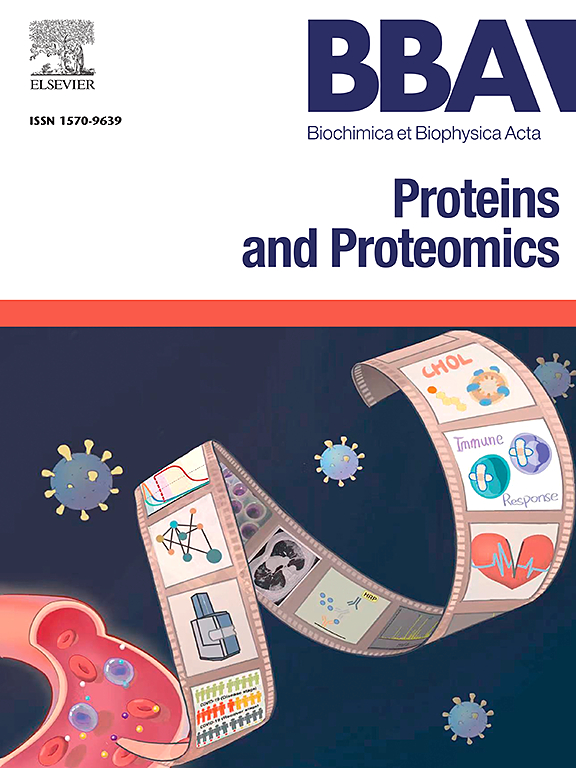来自海葵 Aulactinia veratra 的新型多肽 Avt1 的结构和功能研究。
IF 2.3
4区 生物学
Q3 BIOCHEMISTRY & MOLECULAR BIOLOGY
Biochimica et biophysica acta. Proteins and proteomics
Pub Date : 2024-09-30
DOI:10.1016/j.bbapap.2024.141050
引用次数: 0
摘要
海葵是肽毒素的丰富来源,其生物活性多种多样,通常以离子通道、受体和转运体等蛋白质为靶标。这些多肽毒素及其类似物通常具有高度稳定性和对分子靶标的选择性,因此可作为分子工具、杀虫剂和治疗剂。最近对海葵 Aulactinia veratra 进行的转录组学和蛋白质组学分析发现了一种名为 Avt1 的新型 28 位氨基酸肽。Avt1 采用固相肽合成法制备,然后进行氧化折叠,并使用反相高效液相色谱法纯化折叠肽。合成 Avt1 的液相色谱-质谱图显示了一个纯峰,其分子质量比还原型多肽的分子质量小 6 Da,表明成功形成了三个二硫键。核磁共振测定的溶液结构显示,Avt1 采用了抑制剂胱氨酸结(ICK)折叠,其中两个二硫键形成一个环,第三个二硫键穿透环形成假结。这种结构使 ICK 肽具有很高的结构稳定性、热稳定性和蛋白水解稳定性。与 ICK 结构相一致,Avt1 可抗胰蛋白酶、糜蛋白酶和胃蛋白酶的蛋白水解,但它不是胰蛋白酶抑制剂。在贴片钳电生理试验中,100 nM 的 Avt1 对几种哺乳动物电压门控离子通道没有活性,但其结构特征与针对昆虫钠离子通道的毒素相似。虽然在一些海葵中发现了 Avt1 的序列同源物,但这是该家族中第一个在结构和功能上进行表征的代表。本文章由计算机程序翻译,如有差异,请以英文原文为准。
Structure and functional studies of Avt1, a novel peptide from the sea anemone Aulactinia veratra
Sea anemones are a rich source of peptide toxins spanning a diverse range of biological activities, typically targeting proteins such as ion channels, receptors and transporters. These peptide toxins and their analogues are usually highly stable and selective for their molecular targets, rendering them of interest as molecular tools, insecticides and therapeutics. Recent transcriptomic and proteomic analyses of the sea anemone Aulactinia veratra identified a novel 28-residue peptide, designated Avt1. Avt1 was produced using solid-phase peptide synthesis, followed by oxidative folding and purification of the folded peptide using reversed-phase high-performance liquid chromatography. The liquid chromatography-mass spectrometry profile of synthetic Avt1 showed a pure peak with molecular mass 6 Da less than that of the reduced form of the peptide, indicating the successful formation of three disulfide bonds. The solution structure determined by NMR revealed that Avt1 adopts an inhibitor cystine knot (ICK) fold, in which a ring is formed by two disulfide bonds with a third disulfide penetrating the ring to create the pseudo-knot. This structure provides ICK peptides with high structural, thermal and proteolytic stability. Consistent with its ICK structure, Avt1 was resistant to proteolysis by trypsin, chymotrypsin and pepsin, although it was not a trypsin inhibitor. Avt1 at 100 nM showed no activity in patch–clamp electrophysiological assays against several mammalian voltage-gated ion channels, but has structural features similar to toxins targeting insect sodium ion channels. Although sequence homologues of Avt1 are found in a number of sea anemones, this is the first representative of this family to be characterised structurally and functionally.
求助全文
通过发布文献求助,成功后即可免费获取论文全文。
去求助
来源期刊
CiteScore
8.00
自引率
0.00%
发文量
55
审稿时长
33 days
期刊介绍:
BBA Proteins and Proteomics covers protein structure conformation and dynamics; protein folding; protein-ligand interactions; enzyme mechanisms, models and kinetics; protein physical properties and spectroscopy; and proteomics and bioinformatics analyses of protein structure, protein function, or protein regulation.

 求助内容:
求助内容: 应助结果提醒方式:
应助结果提醒方式:


